
|
The Battle of Brunanburh AD 937 (Bromborough) based on information provided by Prof Stephen Harding. Author of Viking Mersey (2002) and a major contributor to a recently published authoratitive casebook on the battle, edited by Michael Livingston (see image) Brunburg (1100-35) Bruna’s stronghold From Old English personal name burh. Or from the Anglo-Saxon brun meaning brown or dark, with burh meaning fortress, the dark man’s fortress. Bronbur 1153; Bromborough 1277; Brumburg 1280. |
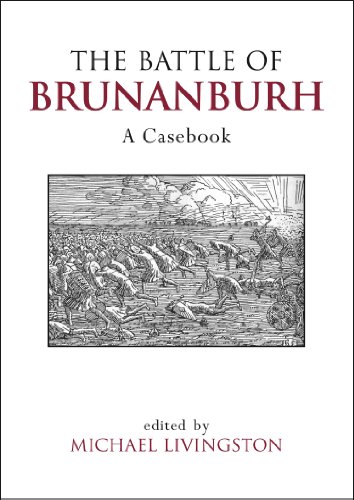 |
|
http://www.amazon.co.uk/Battle-Brunanburh-Casebook-Michael-Livingston/dp/0859898636 The following is largely taken from Prof Stephen Hardings' own website on the battle of Brunanburh www.nottingham.ac.uk/ncmh/dna/Brunanburh.htm with additions by myself |
|
The Battle of Brunanburh was one of the most defining battles in the history of the British Isles and, as described by BBC Broadcaster Neil Oliver in History of Scotland it determined whether Britain would become one imperial power or stay as separate identities. Although the Northern Alliance of Scots, Strathclyde British and Norsemen from Ireland lost the battle against a combined Anglo-Saxon army from Mercia and Wessex - with heavy losses on both sides - the strong resistance proved decisive in what was to follow.
The Battle of Brunanburh is recorded as a contemporary (or near
contemporary) poem in the Anglo Saxon Chronicle, and almost certainly
took place on Wirral. Compelling arguments had earlier been made for
other locations, notably in Lancashire, Yorkshire, Lincolnshire,
Northants and SW Scotland. However the weight of scholarly opinion
is now heavily on Wirral – the debate now seems to be where on Wirral –
and how did they get there. |
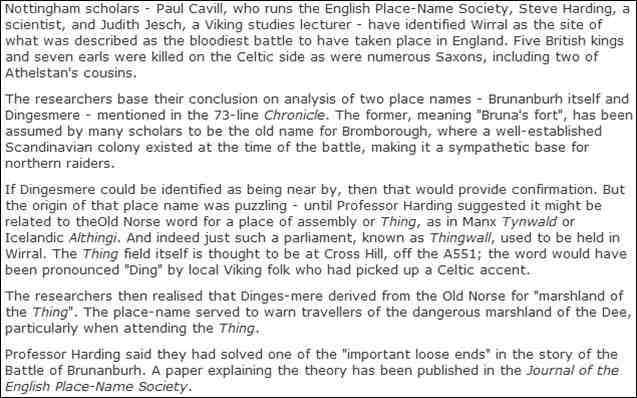 |
| The Anglo-Saxon poem, in its translated version from William of Malmesbury reads as follows (see Campbell, A. The Battle of Brunanburh, London 1938 and Hamer, R. A Choice of Anglo-Saxon Verse, Selected, with an Introduction and a Parallel verse translation, Faber and Faber 1970) |
|
King Athelstan, the lord of warriors, Patron of heroes, and his brother too, Prince Edmund, won themselves eternal glory In battle with the edges of their swords Round Brunanburh; they broke the wall of shields, The sons of Edward with their well-forged swords Slashed at the linden-shields; such was their nature From boyhood that in battle they had often Fought for their land, its treasures and its homes, Against all enemies. Their foes fell dead, The Scottish soldiers and their pirate host Were doomed to perish; and with blood of men The field was darkened from the time the sun Rose at the break of day, the glorious star, God the eternal Lord's bright candle passed Across the land, until this noble creature Sank to its resting-place. There many men Lay slain by spears, and northern warriors Shot down despite their shields, and Scotsmen too, Weary, with battle sated. The West Saxons Throughout the whole long passing of the day Pressed on in troops behind the hostile people, Hewed fiercely from the rear the fleeing host With well-ground swords. The Mercians refused Hard battle-play to none among the fighters Who came with Anlaf over rolling seas, Bringing invasion to this land by ship, Destined to die in battle. Five young kings Lay dead upon the battlefield, by swords Sent to their final sleep; and likewise seven Of Anlaf's earls, and countless of his host, Both Scots and seamen. There the Norsemen's chief Was put to flight, and driven by dire need With a small retinue to seek his ship. The ship pressed out to sea, the king departed Onto the yellow flood and saved his life. Likewise the wise old Constantinus came, The veteran, to his northern native land By flight; he had no reason to exult In that encounter; for he lost there friends And was deprived of kinsmen in the strife Upon that battlefield, and left his son Destroyed by wounds on that grim place of slaughter, The young man in the fight. The grey-haired man Had little cause to boast about that battle, The sly old soldier, any more than Anlaf; They could not with their remnant laugh and claim That they were better in warlike deeds When banners met upon the battlefield, Spears clashed and heroes greeted one another, Weapons contended, when they played at war With Edward’s sons upon the place of carnage. The Norsemen left them in their well-nailed ships, The sad survivors of the darts, on Dingesmere Over the deep sea back they went to Dublin, To Ireland they returned with shameful hearts. The brothers also both went home together, The king and prince returned to their own country, The land of Wessex, triumphing in war. They left behind corpses for the dark Black-coated raven, horny beaked to enjoy, And for the eagle, white-backed and dun-coated, The greedy war-hawk, and that grey wild beast The forest wolf. Nor has there on this island Been ever yet a greater number slain, Killed by the edges of the sword before this time, as books make known to us, and old And learned scholars, after hither came The Angles and the Saxons from the east Over the broad sea sought the land of Britain, Proud warmakers. Victorious warriors, Conquered the Welsh, and so obtained this land. |
|
|
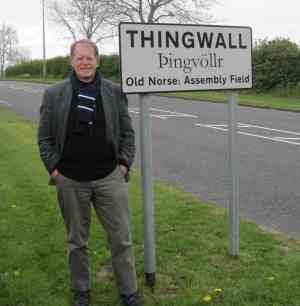 Stephen Harding |
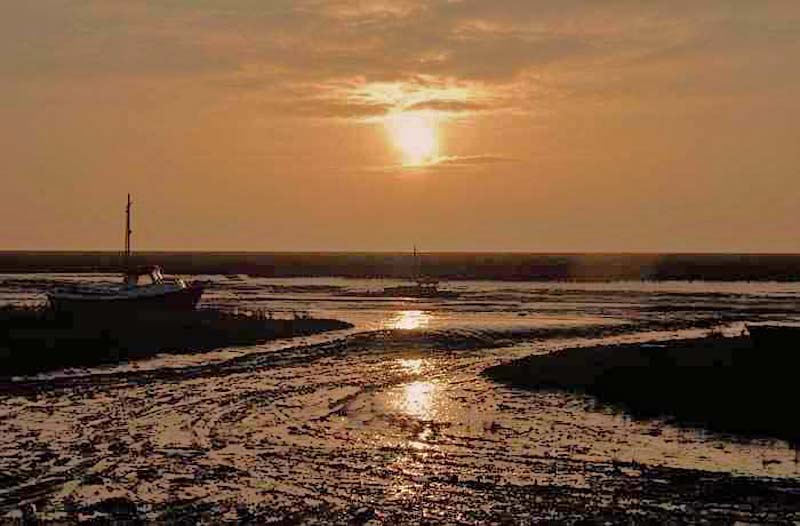
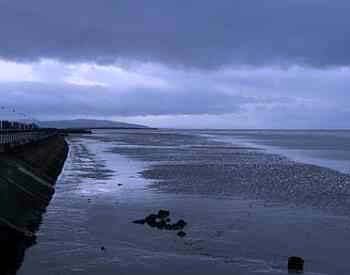 Heswall Point, (left) one of the possible escape routes to Dublin after the Battle. The other being Meols source: http://www.nottingham.ac.uk/ncmh/dna/Brunanburh.htm |
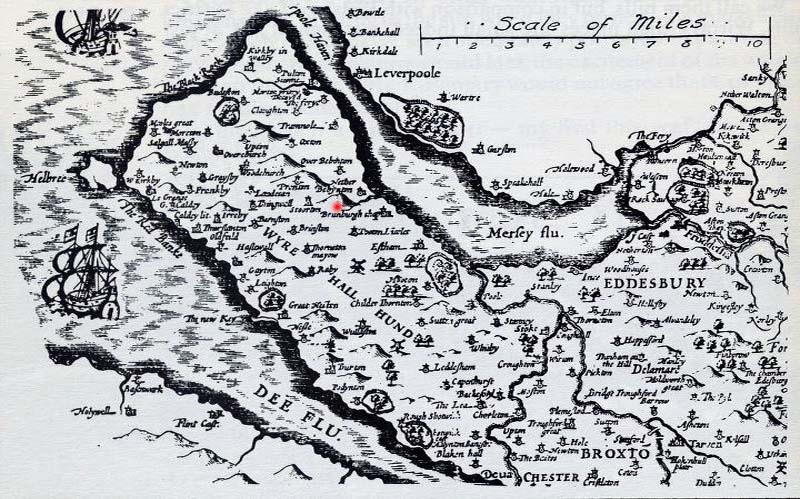 Brunaburgh (937AD) is marked (red dot) in this 1611 map |
|
I spoke
to Prof Harding, via email, about the accuracy of old maps in
research and mentioned one, dated 1611, which purports to show a
'Moreton Priory' giving the location as the present ruins of
Birkenhead Priory. This was discussed at length via a Facebook local
history group and I decided to contact Stephen for his views: his
reply:
I am not familiar with
the 1611 map:
the map I have is the 18th century map
of Herman Moll.
It shows “Moreton” with “Pri.”
underneath with the location point in Birkenhead.
It could well have been a mistake that
Moll has repeated.
Birkenhead certainly existed (1st
recorded as Bircheveth 1190-1216) but was probably considered too minor
to make the maps, along with many other places (Irby, Raby etc.). I used the Moll map,
not because of the Priory – which isn’t really relevant to the Vikings –
but because it illustrated the old name for Wallasey Village (Kirkby)
and the old name for Bromborough (Brunburgh).
It was whilst looking at this map in
2004 that I made a crucial identification in the location debate over
the “Great War of AD937” – the Battle of Brunanburh: namely that the
place of escape referred to in the old Anglo Saxon poem as “Dingesmere”
was the “Thing’s mere” – the waterway/wetland associated with the Thing
at Thingwall, an identification subsequently confirmed by the English
Place Name Society:
http://www.nottingham.ac.uk/ncmh/dna/Brunanburh.htm
|
| Stephen Harding on historical research in reply
to a question from me:
Historical research is now multi-disciplinary and inter-disciplinary –
particularly in my own particular area of interest - Vikings in the
North West – which not only involves trained historians but also
scientists like myself, place-name experts, surname experts, linguistic
experts and archaeologists – working together, and, most importantly,
also with the public. An example is here: |
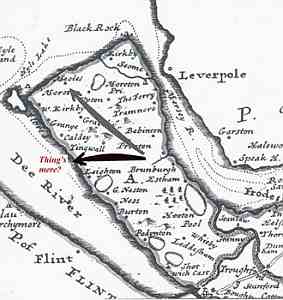 Probable escape routes after the Battle, based on documentary evidence |
|
Place name evidence may link this settlement battle of Brunanburgh
in 937 AD documented in the Anglo-Saxon Chronicles, although the
exact location of the battle is unknown. Within Wirral, it is
thought that it may have taken place near the shoreline, in an area
now developed for industrial use. A monastery was established in
Bromborough, west of the Saxon Church in 912 AD, it is thought by
Aethelfleada, the daughter of Alfred the Great.
http://www.liverpoolmuseums.org.uk/mol/collections/historic-characterisation-project/Wirral-Part-6.pdf
|
|
Recent Academic Papers: Battle of Brunanburh: extract from book by Paul Cavill (English Place Name Society) – Vikings: Fear and Faith in Anglo-Saxon England, Harper Collins Publishers, London & Glasgow, 2001, pages 97-111. The Context of Brunanburh. Chapter by Prof. N.J. Higham (University of Manchester) in Names, Places, People. An Onomastic Miscellany in Memory of John McNeal Dodgson (ed. A.R. Rumble and A.D. Mills), Paul Watkins, Stamford, 1997, pages 144-156 – places the “Plains of Othlynn” referred to in Irish annals – in the region south of the Mersey – and gives a critical appraisal of claims for a Yorkshire location for the battle. Revisiting Dingesmere. Journal of the English Place Name Society, October 2004, volume 36, pages 25-38. Article by Paul Cavill, Stephen Harding and Judith Jesch suggesting a solution to a mystery concerning the Battle of Brunanburh – the identification of Dingesmere as the “Things – mere or – marr”, the wetland or marshland associated with the Thing – the Viking parliament, at Thingwall on Wirral. The Wirral Carrs and Holms. Journal of the English Place Name Society, December 2007 volume 39, pages 45-57. Article by Steve Harding on the distribution of the carrs (ON kjarr) and holms (ON holmr) in Wirral - old Norse names associated with marshland - and their significance in terms of dialect (and in relation to the total absence of corresponding English names for the same features) - and possible relevance to the Battle of Brunanburh. The site of the battle of Brunanburh: manuscripts and maps, grammar and geography. Article by Paul Cavill in A Commodity of Good Names. Essays in Honour of Margaret Gelling (edited by O.J. Padek and D.N. Parsons), Shaun Tyas, Donington UK, pages 303-319, 2008. The Place-Name Debate: Chapter by Paul Cavill, in The Battle of Brunanburh. A Casebook (edited by Michael Livingston), University of Exeter Press (May, 2011). Concludes that Wirral was the site of the battle. Wirral: folklore and locations: Chapter by Steve Harding, in The Battle of Brunanburh. A Casebook (edited by Michael Livingston), University of Exeter Press (May, 2011). Assuming a Wirral location examines where “ymbe Brunanburh” the battle may have been fought, two possible sites where Bruna’s “burh” may have been and also the possible location for the “Thing’s mere”. Lecture on Brunanburh (Given by Dr. Paul Cavill at the Chester Viking Conference, 20th November 2010) New Book: The Battle of Brunanburh. A Casebook (edited by Michael Livingston, May, 2011), Exeter University Press. Amazon link (UK) and Amazon.com. http://www.nottingham.ac.uk/ncmh/documents/dna/Brunanburh-LocationsChapter-May09.pdf Amateur/Schools: Sites no longer exist http://www.nottingham.ac.uk/csva/index.aspx Centre for study of Viking Age
Local Magazine article:
http://www.nottingham.ac.uk/Biosciences/People/steve.harding
I would like to add a personal accolade to this page. Professor Stephen Harding gave me a large portion of his time, over the Christmas (2013) period in order to help me get this page as accurate as is historically possible and sent me a veritable mountain of material, some of which I would like to add at some future date. Please bear in mind much of this is reproduced with permission and I have added some items myself. My immense thank you to Stephen, to all his wonderful associates and I have copied all his page links across to this one - they make for fascinating reading. Thank you one, and all, live long and prosper! I am not a learned scholar; I do this for enjoyment and satisfaction and no personal gain and in the hope that if I can help one person then it is as they say today - job done! Mike Kemble, Sutton Coldfield. Dec 2013. |
 |